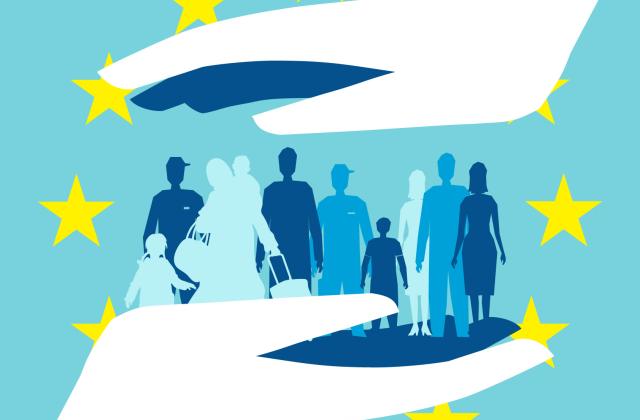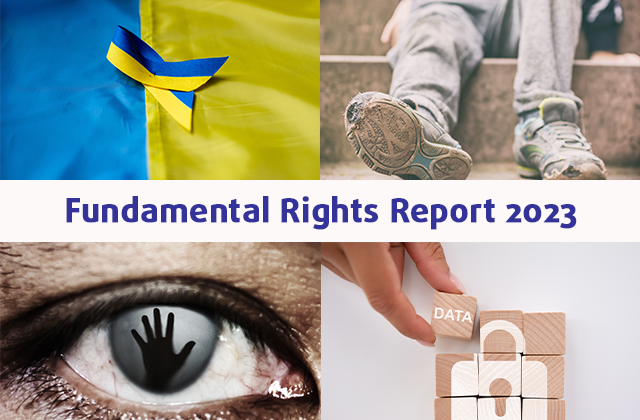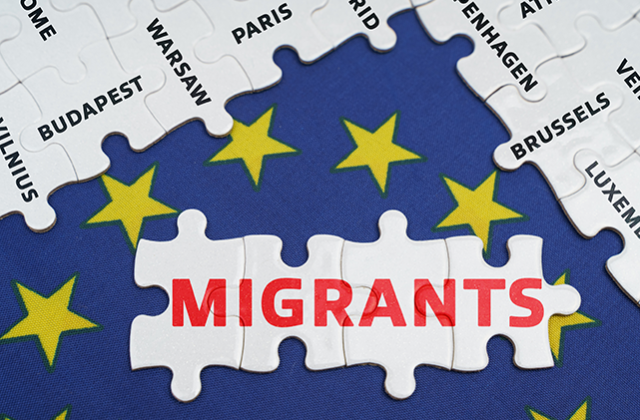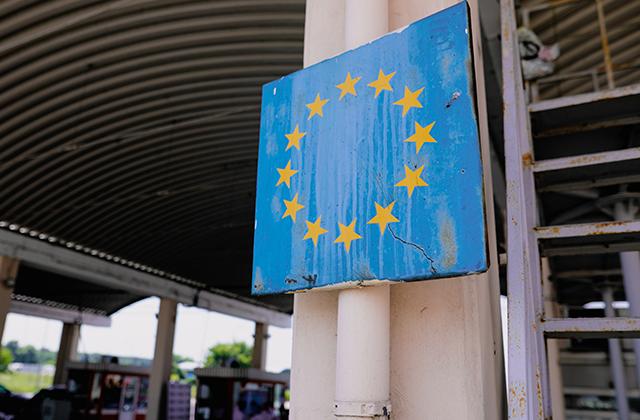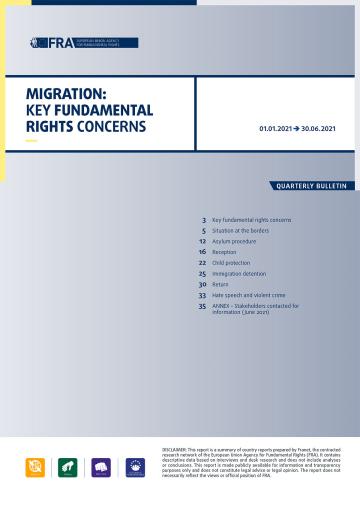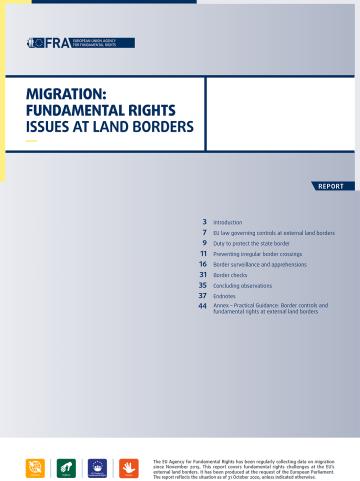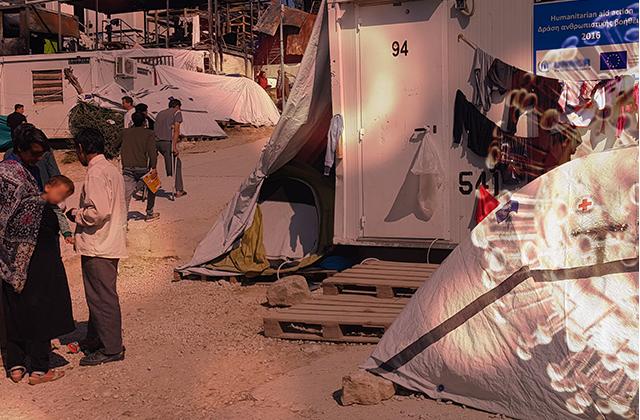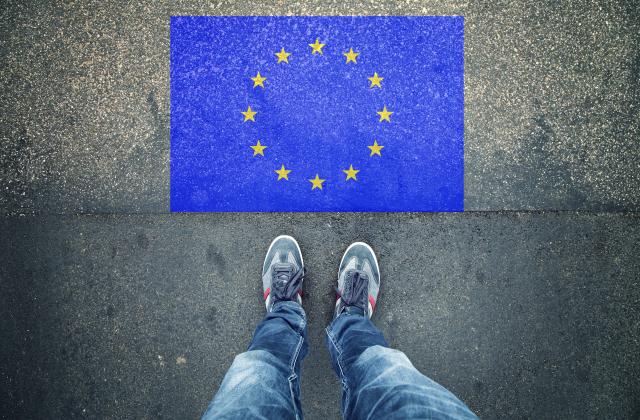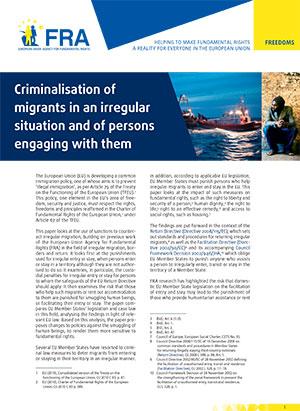- The Commission’s Competence Centre on Foresight describes the trend of militarisation of borders.
-
Pursuant to Article 42 of the TEU, the EU’s common defence policy is an integral part of its CFSP. Such policy is defined and implemented by the European Council and the Council of the European Union, acting unanimously. The EU institutions act mainly via Council decisions, and the jurisdiction of CJEU is limited (Article 24(1) of the TEU and Article 275(1) of the TFEU). Member States typically act outside the scope of EU law in defence matters and are therefore not bound by the Charter, which, in accordance with Article 51(1), binds the Member States only when implementing EU law. Still, Member States are bound by international law, including the ECHR and the 1951 Convention relating to the Status of Refugees, and by national constitutional law [107]
See, for example, judgment of the Court of Justice of 10 March 2021, M.A. v Konsul Rzeczypospolitej Polskiej w N., C-949/19, ECLI:EU:C:2021:186, paragraph 36.
. -
Border management activities have always been inherently linked to the protection of territorial sovereignty. Cooperation with military actors at borders is not new but has gained increasing importance. The 2025 European internal security strategy considers that ‘strengthening the resilience and security of external borders is crucial to counter hybrid threats.’ The white paper for European defence readiness 2030 of March 2025 alludes to an increasing interplay between border protection and defence [108]
Joint white paper for European defence readiness 2030, JOIN(2025) 120 final of19 March 2025. See, in this context, Niinistö, S., Report: Safer Together – Strengthening Europe’s civilian and military preparedness and readiness, 2024, p. 29.
. -
The trend of militarising the borders, however, has brought along a spurious discourse considering people on the move as ‘weapons’ and ‘enemies’, a label which contradicts international humanitarian law [109]
See the relevant definitions and concepts of the four 1949 Geneva Conventions (and the two 1977 Protocols thereto) and the 1899 and 1907 Hague Conventions on the laws of war.
. Such people are oftentimes vulnerable and victims of rights violations or even crime. -
Under the concept of European integrated border management in Article 3 of the EBCG Regulation, border guards should cooperate with authorities carrying out other tasks at the border, including the military [110]
See, in this context, Policy document developing a multiannual strategic policy for European integrated border management in accordance with Article 8(4) of Regulation (EU) 2019/1896, COM(2022) 303 final of 24 May 2022 (component 5); and Communication from the Commission to the European Parliament and the Council establishing the multiannual strategic policy for European integrated border management, COM(2023) 146 final of 14 March 2023 (component 7).
. Whereas military activities at the border largely fall outside of the scope of EU law, when the military carries out border management functions, their actions are governed by it, and the Charter applies. - This chapter deals with measures to counter instrumentalisation as a form of hybrid threat which may blur the lines between border management and defence policies, highlighting potential fundamental rights risks that such blurring may create. It first analyses information exchanges, operational assistance and dual-purpose research and innovation and then describes physical barriers at borders.
- Under EU law, the European border surveillance system (Eurosur) is the framework for the exchange of information to improve border guards’ situational awareness and to increase reaction capability. It should provide border management authorities with better awareness of the situation at the border and contribute to ‘ensuring the protection and saving the lives of migrants’ (EBCG Regulation, Article 18).
- In accordance with Article 25 of the EBCG Regulation, Member States must maintain a national situational picture ‘to provide all authorities having responsibility for external border control at national level with effective, accurate and timely information.’ Such a situational picture contains an operational layer (Article 24 of the EBCG Regulation) with information on deployment plans, areas of operations and deployed assets. In many border areas this also includes military assets. Acknowledging the sensitivity of such information, Article 25(4) of the EBCG Regulation allows Member States to restrict information on military assets on a need-to-know basis.
- EU law explicitly acknowledges the need to share information between border management and military authorities, at least insofar as these exercise border management functions. As Eurosur is regulated by EU law, military authorities having access to Eurosur data are bound by its rules, as any other national authority. Article 89(5) of the EBCG Regulation bans sharing data with third countries which ‘could be used to identify persons or groups of persons … who are under a serious risk of being subjected to torture, inhuman and degrading treatment or punishment, or any other violation of fundamental rights'.
- Under EU law, sharing Eurosur information with military authorities who do not have border management functions is not envisaged but also not prohibited. In any event, this would not impact applicable safeguards. If, for example, information on migrants approaching the border is shared, military authorities are bound to respect the principle of non-refoulement and are barred from intercepting and informally returning them across the border.
- Under Article 16 of the Schengen Borders Code, border control functions must be carried out by professional border guards. Member States must ensure that border guards are specialised and properly trained, also based on the Frontex common core curricula for border guards.
-
In line with national legislation, military resources and assets may support border management [111]
Policy document developing a multiannual strategic policy for European integrated border management in accordance with Article 8(4) of Regulation (EU) 2019/1896, COM(2022) 303 final of 24 May 2022, p. 20.
. At land borders, soldiers have been assisting border guards for decades. For example, in 1990, the Austrian government requested the army to support the police with controls at the border with Hungary [112]
See The Austrian Armed Forces, ‘Geschichte ab 1955’ ‘[History since 1955]’, Bundesheer.at website. See also, Sadrić, B., ‘The use of military forces in the protection of the borders and prevention of irregular migrations in selected South East European countries’ Croatian and Comparative Public Administration, Vol. 19. No 3, 27 September 2019, pp. 473–499.
. The trend of the militarisation of borders may lead to further entrusting military staff with supporting border control functions. These may include tasks that involve coercive measures. - Military personnel may support border management authorities by patrolling the border and detecting unauthorised border crossings. When they do so, they carry out their task under the instructions of the responsible national border management authority. Whereas military activities at the border largely fall outside of the scope of EU law, when the military carries out border management functions, their actions are governed by it, and the Charter applies. In case military personnel violate the law when exercising such support tasks – for example by using excessive force during apprehensions – they remain accountable for fundamental rights violations.
-
EU border management standards require that staff have a high degree of specialisation and professionalism, and a diverse skill set. At the EU’s external land border, FRA noted that in some Member States, low-ranking staff without full border guard training and military personnel engage in border patrol and apprehensions of new arrivals [113]
FRA, Asylum and Migration: Progress achieved and remaining challenges, Publications Office of the European Union, Luxembourg, 2023.
. This poses fundamental rights risks.
- Research and innovation is another area where more synergies between border management and defence policies are likely to occur.
-
Under the concept of European integrated border management, Member States and Frontex should make the best use of modern technology. They should reduce dependencies on third countries as regards critical technologies. The Observatory on Critical Technologies should monitor and analyse these [114]
Policy document developing a multiannual strategic guidance for European integrated border management in accordance with Article 8(4) of Regulation (EU) 2019/1896, COM(2022) 303 final of 24 May 2022 (components 10 and 15).
. -
When describing the trend of the militarisation of borders, the Commission’s Competence Centre on Foresight refers to ‘an increase in the use of military technologies, hardware and personnel, and in some cases even the transfer of this responsibility to military forces.’ From a defence policy angle, in October 2021, European leaders affirmed their commitment to strengthening Europe’s defence technological and industrial base and fostering synergies between civil, defence and space industries [115]
European Council, ‘Statement of the Members of the European Council’, 26 February 2021, paragraph 13.
. -
This may lead to dual-purpose technologies being developed and deployed at land and sea borders. Under EU law, dual-use items are those which can be used for civil and military purposes [116]
Regulation (EU) 2021/821 of the European Parliament and of the Council of 20 May 2021 setting up a Union regime for the control of exports, brokering, technical assistance, transit and transfer of dual-use items (recast), OJ L 206, 11.6.2021, p. 1, ELI: http://data.europa.eu/eli/reg/2021/821/oj, Article 2(1).
. -
The example of high-altitude pseudo-satellites (HAPS) illustrates this. HAPS are unmanned aircraft positioned for longer periods in the stratosphere. According to the European Space Agency, HAPS may support a diverse range of activities ranging from telecommunications to environmental monitoring. Defence-related research is exploring how to use them to improve their intelligence, surveillance and reconnaissance capabilities [117]
See, for example, Permanent Structured Cooperation, ‘European high atmosphere airship platform (EHAAP) – persistent intelligence, surveillance and reconnaissance (ISR) capability (EHAAP)’, Permanent Structured Cooperation website; and European Defence Fund, ‘EuroHAPS’, European Union, 2022.
. In 2022 and 2023, Frontex studied the use of HAPS for border management purposes, focusing on three use cases: earth observation, navigation and communication [118]
Frontex, High Altitude Pseudo-Satellites: HAPS final report, Frontex – European Border and Coast Guard Agency, Warsaw, 2023.
. The Frontex study also included a preliminary assessment of the impact on fundamental rights, drafted with FRA’s support, looking at the fundamental rights implication of the specific use cases envisaged [119]
Frontex, ‘Preliminary assessment of the impact on fundamental rights: HAPS final report’, Frontex – European Border and Coast Guard Agency, Warsaw, 2023.
. -
In January 2024, the Commission presented options to support research and development involving technologies with dual-use potential. It notes that the integration of new technologies developed through defence funding into the civil sector is limited. Increasing the EU’s resilience is a priority for both defence and internal security needs, including to deter border-related security threats. One of the options the Commission presents is a new dedicated instrument with a specific focus on research and development with dual-use potential. It lists ‘EU autonomous vehicles’ in support of defence and border control, as an example of a flagship project for which the EU could be the lead customer [120]
White paper on options for enhancing support for research and development involving technologies with dual-use potential, COM(2024) 27 final of 24 January 2024, pp. 11–12.
. - Efforts to enhance the dual use of research and innovation may result in circumventing the fundamental rights safeguards that EU law provides for border management. Pursuant to Article 3(2) of the EBCG Regulation, research and innovation in border management is a horizontal component of European integrated border management and, as such, must contribute to managing external borders in full compliance with fundamental rights (EBCG Regulation, Article 1). When carried out by Member States, defence-related research is not subject to requirements flowing from the Charter nor to safeguards embedded in secondary EU law, such as those set out in the Artificial Intelligence Act (Regulation (EU) 2024/1689) for high-risk AI. Even where research is funded through the European Defence Fund, in accordance with Article 7 of Regulation (EU) 2021/697, the scrutiny focuses on ethical issues rather than fundamental rights as legal obligations.
-
Several Member States at the external EU border have erected fences or other physical barriers. By the end of 2022, the total length of such border fences amounted to some 2 000 km [121]
FRA, Asylum and Migration: Progress achieved and remaining challenges, Publications Office of the European Union, Luxembourg, 2023, p. 8. See also European Parliamentary Research Serviceand Dumbrava, C., ‘Walls and fences at EU borders’, European Parliament briefing, October 2022.
. Although such fences have primarily been erected to counter irregular immigration, according to the white paper for European defence readiness 2030, physical barriers may also serve to counter military and hybrid threats. The white paper mentions explicitly the Eastern Border Shield, a defence system along the land border with Belarus and the Russian Federation [122]
For information about the plans, see DefenseMirror.com, ‘Poland to invest $2.55B on “East Shield” Border Project with Russia, Belarus’, DefenseMirror.com website, 24 April 2025.
. - Erecting fences, although in themselves not contrary to EU law, may interfere with various fundamental rights, as FRA described in its 2024 fundamental rights report (pages 95–96) when analysing fences in support of border management.
-
EU law requires that border management must respect the right to seek asylum [123]
Regulation (EU) 2016/399 of the European Parliament and of the Council of 9 March 2016 on a Union Code on the rules governing the movement of persons across borders (Schengen Borders Code), OJ L 77, 23.3.2016, p. 1, ELI: http://data.europa.eu/eli/reg/2016/399/oj, Article 4; and Regulation (EU) 2019/1896 of the European Parliament and of the Council of 13 November 2019 on the European Border and Coast Guard and repealing Regulations (EU) No 1052/2013 and (EU) 2016/1624, OJ L 295, 14.11.2019, p. 1, ELI: http://data.europa.eu/eli/reg/2019/1896/oj, Article 80.
. Border fences without gates at reasonable distances and which are not also reachable by people with vulnerabilities limit the ability of people in need of international protection to seek safety. Fences without gates undermine the essence of the right to asylum that Article 18 of the Charter guarantees. -
Features such as coil-shaped blades or wires giving high electric shocks put people’s lives at risk or create a risk of disproportionate harm. In Poland, for example, MSF reported that many of the patients it treated at the Belarus border had injuries caused by a razor wire fence [124]
MSF, ‘People continue to cross Belarus–Poland border in search of safety in Europe’, MSF website, 19 December 2023.
. Spain removed the blades from its fences in Ceuta and Melilla in 2020 [125]
FRA, Migration: Fundamental rights issues at land borders, Publications Office of the European Union, Luxembourg, 2020, p. 15.
. High-security features, which may be justified to protect critical infrastructure, are not proportionate when used on border fences that people may be forced to cross in the absence of alternatives to seek safety. - Fences may also pose obstacles to offering life-saving assistance, such as emergency medical assistance, along with food, water and other essential items, to people stranded in between borders.
- In some cases, border fences may also have an impact on local communities’ livelihoods, for example if the fence impedes access to a border lake or river used for economic activities (e.g. tourism and transport). Border fences could thus potentially affect the freedom to conduct a business, provided by Article 16 of the Charter.
-
Additionally, should fences be funded by the EU, this may also raise issues under Article 37 of the Charter (environmental protection), when constructed in or near a special area of conservation, as defined in Article 1(l) of Directive 92/43/EEC, such as national parks. Like other linear infrastructure such as roads or railways, border fences hinder or harm wildlife, according to scientists [126]
See, for example, Linnell, J.D.C., Trouwborst, A., Boitani, L., Kaczensky, P., Huber, D. et al., ‘Border security fencing and wildlife: The end of the transboundary paradigm in Eurasia?’, PLOS Biology, Vol. 14, No 6, 22 June 2016; Trouwborst, A., Fleurke, F. and Dubrulle, J., ‘Border fences and their impacts on large carnivores,large herbivores and biodiversity: An international wildlife law perspective’, Review of European, Comparative & International Environmental Law, Vol. 25, No 3, 4 October 2016; Nowak, S., Szewczyk, M., Stępniak, K. M., Kwiatkowska, I., Kurek, K. et al.,‘Wolves in the borderland –Changes in population and wolf diet in Romincka Forest along the Polish–Russian–Lithuanian state borders’, Wildlife Biology, Vol. 2024, No 6, 5 March 2024; Peters, R., Ripple, W. J., Wolf, C., Moskwik, M., Carreón-Arroyo, G. et al., ‘Nature divided, scientists united: US–Mexico border wall threatens biodiversity and binational conservation’, BioScience, Vol. 68, No 10, October 2018, pp. 740–743; and Nowak, K., Adamowski, W., Bubnicki, J. W., Jaroszewicz, B., Komar, E. et al., ‘Understanding and mitigating the ecological footprint of state border barriers – Final project report to NAWA’,2025.
. For example, a country road upgrade fragmented the habitat of the Iberian lynx, according to the CJEU [127]
Judgment of the Court of Justice of 20 May 2010, Commission v Spain, C-308/08, ECLI:EU:C:2010:281, paragraph 25.
. Under Article 6(3) of the directive, infrastructure projects require a prior impact assessment. For projects needed for imperative reasons of overriding public interest, under Article 6(4), Member States must take the necessary compensatory measures. - The trend to militarise borders may lead to erecting more or stronger physical barriers at the EU’s external land border. EU law applies when fences are constructed for border management. In such cases, it requires that they be designed in a way that respects the essence of the right to asylum, enables life-saving assistance to people stranded at borders, and does not disproportionately interfere with other fundamental rights, such as the right to physical integrity in Article 3 of the Charter.
- The trend to militarise borders risks blurring the line between border management and defence policies.
- Border management authorities may share certain operational information with the military. Such sharing of information is regulated by Eurosur, which is the framework for information exchange to improve border guards’ situational awareness and to increase reaction capability. Eurosur is regulated by EU law and information exchanges under this framework must be implemented in full compliance with the Charter. Military authorities that would receive Eurosur information, for example, on the detection of a group of migrants at the border, are bound by the duty to respect fundamental rights, including the principle of non-refoulement. They must also respect the safeguard in Article 89(5) of the EBCG Regulation, which bans sharing data with third countries that ‘could be used to identify persons or groups of persons … who are under a serious risk of being subjected to torture, inhuman and degrading treatment or punishment, or any other violation of fundamental rights’.
- The trend of the militarisation of borders may lead to further entrusting military staff with supporting border control functions. These may include tasks that involve the use of coercive measures. The exercise of these tasks falls under EU law on border management and any actor involved must respect the rights set out in the Charter. This requires that any person carrying out border management functions must be sufficiently trained on fundamental rights. They must receive clear and unambiguous instructions on the limits of the use of force, the prohibition of ill-treatment and the need to refer any apprehended third-country national to the responsible border management authority.
- Infrastructure and technology may serve a dual purpose – civilian and military. Border management, as part of Title V of the TFEU (area of freedom, security and justice), falls under the scope of EU law and the Charter applies. In defence matters, Member States typically act outside the scope of EU law and therefore they will mostly not be bound by EU fundamental rights law and the Charter. Dual-purpose technologies may be designed by defence actors and subsequently deployed at borders. Efforts to enhance the dual use of research and innovation risk circumventing the fundamental rights safeguards that EU law provides in the field of border management and discourage the carrying out of fundamental rights impact assessments.
- The trend to militarise borders may lead to erecting more or stronger physical barriers at the EU’s external land border. EU law applies when fences are constructed for border management. In such cases, EU law requires that they be designed in a way that respects the essence of the right to asylum, enables life-saving assistance to people stranded at borders and does not disproportionately interfere with other fundamental rights, such as the right to physical integrity in Article 3 of the Charter. When Member States erect fences to defend their territory, they normally act outside the scope of EU law and the fundamental rights safeguards in the Charter do not apply, although obligations that Member States have under international human rights and refugee law remain unaffected.





